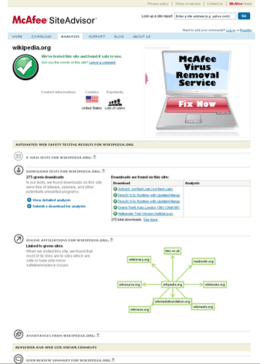McAfee SiteAdvisor
 | |
|
The McAfee SiteAdvisor Website showing the review for Wikipedia | |
| Developer(s) | McAfee |
|---|---|
| Initial release | April 2005 |
| Operating system | Cross-platform |
| Website |
web |
The McAfee SiteAdvisor, later renamed as the McAfee WebAdvisor, is a service that reports on the safety of web sites by crawling the web and testing the sites it finds for malware and spam. The service was originally developed by SiteAdvisor, Inc, an MIT startup[1] first introduced at CodeCon on February 10, 2006[2] and later acquired by McAfee[3] on April 5, 2006. Since its founding, it has received criticism for its improper rating of some sites, and more importantly the length of time it takes to resolve complaints.
Usage
Prior to mid-October, 2014, the functionality of SiteAdvisor could be accessed by submitting a URL to the website at https://www.siteadvisor.com/sites/, but can now also be accessed through a downloadable Browser Plugin.[4]
SiteAdvisor LIVE
A paid version of McAfee SiteAdvisor, McAfee SiteAdvisor LIVE, is included in McAfee Total Protection and has extra features:
- Download Protection - SiteAdvisor LIVE allows the consumer to adjust how aggressive SiteAdvisor scans downloads. This can stop downloads which are considered to be slightly, probably or possibly risky depending on setting determined by the user. This feature can also be turned off.
- Protected Mode - Allows the user to set a password for SiteAdvisor to prevent users from accessing or downloading from Yellow and Red rated websites. This password will also be required to change any SiteAdvisor settings after Protected Mode has been enabled.
In addition to selling to the end consumers, McAfee also sells to the web site owners with their McAfee Secure program. --
Total Exposure
As of Dec 2010, McAfee Secure marketing materials say there are 350 million installs of McAfee SiteAdvisor, and a likely much larger viewer base with search engine agreements such as that with Yahoo.
Extra features of McAfee SiteAdvisor
- Rates email and IM links
- Indicates sites potentially harmful to your computer
- Allows users to safely shorten URLs when sharing links
- Alerts users to possible phishing and identity theft scams
- Redirects you away from red and yellow sites (if Protected Mode is enabled).
Criticism
False positives
SiteAdvisor has received criticism for incorrectly flagging web sites with a caution or warning label.[5][6][7]
False negatives
The very nature of SiteAdvisor and the long periods between site crawls mean that even if the SiteAdvisor tests were 100% accurate a Green rating offers no guarantee of safety. Malicious code and browser exploits often spread fast over large numbers of websites,[8] meaning a Green rating may not be up to date and may provide a false sense of security.
Communication and accountability
In the event of a positive result website owners are not contacted. Although a dispute resolution service does exist, the final decision rests with McAfee.[9] In the event that a perceived threat is removed from a site the site's rating will return to Green as the data ages. Depending on the nature of the threat this process can take from 10 days to a year after the site is re-crawled, no strict timetable is provided.[10]
Yahoo, who uses the McAfee SiteAdvisor rating in their search results, does not get the rating change for another 4 weeks. It is unclear if rating changes in either direction take this long, or only corrections (RED to GREEN). Yellow is rarely, if ever, used.
The software design makes it difficult to turn SiteAdvisor off and McAfee keeps changing the method of doing so. The program reinstalls if a customer updates McAfee's Total Protection package.
No ratings on business practices
SiteAdvisor only rates sites based on the risk of malware or spam. Business practices and user reviews are not rated. So sites with D or worse ratings at the Better Business Bureau (e.g. FreeCreditReport.com) can be rated GREEN. This exposes the user to financial risk, despite being protected from malware.
McAfee Secure
This program 'certifies' a web site so that it can show the McAfee certified logo, and also get a GREEN rating beside search results (according to their marketing materials).
TrustedSource
McAfee SiteAdvisor now makes use of the TrustedSource website reputation organisation, to act as something like a 'cloud' intelligence software to get the most up-to-date information on websites as possible, very similar to McAfee's Active Protection (Artemis) system. The details of this system are not known.
Awards
- Time magazine named SiteAdvisor.com among the 50 coolest websites of 2006.[11]
- Popular Science awarded SiteAdvisor the "Best of What's New" award in the Computing category for 2006.[12]
- PC World ranked SiteAdvisor at #15 in "The 100 Best Products of 2007."[13]
See also
References
- ↑ "McAfee acquires MIT startup SiteAdvisor at Digital...".
- ↑ "CodeCon 2006 Program".
- ↑ Dixon, Chris (2006-09-05). "Taking SiteAdvisor to the Next Level". Archived from the original on 2006-05-23. Retrieved 2006-09-05.
- ↑ "Internet Archive Wayback Machine from Oct 12, 2014 shows "View Report Now" option". Archived from the original on October 12, 2014.
- ↑ "Malware Advisor". Retrieved 2008-04-16.
- ↑ "McAfee SiteAdvisor gives PCmag.com yellow warning rating". Retrieved 2008-04-16.
- ↑ "Have you been slandered or defamed by McAfee SiteAdvisor?". Retrieved 2011-01-12.
- ↑ "PC-pwning infection hits 30,000 legit websites". Retrieved 2009-07-18.
- ↑ "What is the process for disputing my site's rating?" (PDF). Retrieved 2009-01-31.
- ↑ "How long does it take for my site rating to change? Can I ask to be re-tested more quickly?" (PDF). Retrieved 2009-01-31.
- ↑ "SiteAdvisor's entry in Time's 50 coolest websites of 2005". 2006-08-03. Retrieved 2006-10-13.
- ↑ "SiteAdvisor's entry in Popular Science's Best of What's New 2006". Retrieved 2007-04-20.
- ↑ "PC World's list of "The 100 Best Products of 2007"". Retrieved 2007-05-23.
